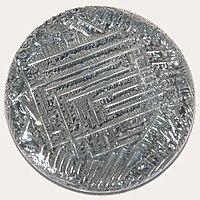
Photo from wikipedia
Li-M-Si ternary Zintl phases have gained attention recently due to their high structural stability, which can improve the cycling stability compared to a bulk Si electrode. Adding multivalent cation salts… Click to show full abstract
Li-M-Si ternary Zintl phases have gained attention recently due to their high structural stability, which can improve the cycling stability compared to a bulk Si electrode. Adding multivalent cation salts (such as Mg2+ and Ca2+) in the electrolyte was proven to be a simple way to form Li-M-Si ternary phases in situ in Si-based Li-ion cells. To explore the promise of Zintl-phase-forming electrolytes, we systematically investigated their application in pouch cells via electrochemical and multiscale postmortem analysis. The introduction of multivalent cations, such as Mg2+, during charging can form LixMySi ternary phases. They can stabilize Si anions and reduce side reactions with electrolyte, improving the bulk stability. More importantly, Mg2+ and Ca2+ incorporate into interfacial side reactions and generate inorganic-rich solid-electrolyte interphase, thus enhancing the interfacial stability. Therefore, the full cells with Zintl-phase-forming electrolytes achieve higher capacity retentions at the C/3 rate after 100 cycles, compared to a baseline electrolyte. Additionally, strategies for mitigating the electrode-level fractures of Si were evaluated to make the best use of Zintl-phase-forming electrolytes. This work highlights the significance of synergistic impact of multifunctional additives to stabilize both bulk and interface chemistry in high-energy Si anode materials for Li-ion batteries.
Journal Title: ACS applied materials & interfaces
Year Published: 2022
Link to full text (if available)
Share on Social Media: Sign Up to like & get
recommendations!